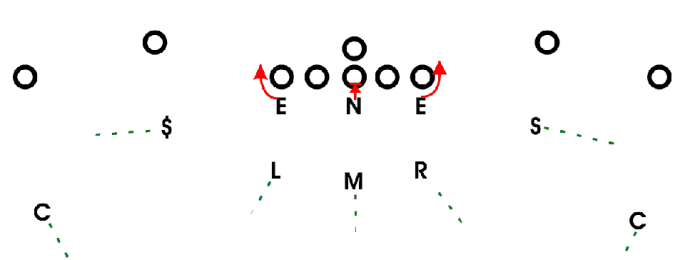General about Defensive Pass Coverages
Coverage is the term for the part of pass defense which tries to prevent that a thrown pass will reach it’s receiver, and if that can’t prevented then at least to prevent, that the receiver can gain any more substantial ground after the catch. In general defensive pass coverages are divided in man-coverages and zone-coverages.
Man Coverage
There are two basic versions of “Man-Coverage”: Man-Coverage with or without Free Safety. The most common version is Man-Coverage with Free-Safety, often called “Man – Free” or “Cover 1”. Man-Coverage without Free Safety is also sometimes called “Cover 0”.
Advantages of Man Coverage
- Easy to coach: “Stay with your man, no matter what he does and where he’s going”.
- There are 5 (“Cover 1”) or even 6 (“Cover 0”) defenders available for the passrush. That means when blitzing there will almost always be Man-Coverage (of course there are exceptions, but this would go to much into details for this article). Should the Runningbacks and/or the Tight End support the pass-blocking, so can in turn their “cover-men” support the passrush.
Disadvantages of Man-Coverage
- not so easy to play: The receiver is i.e. just slightly quicker/faster than the defender and so defender has barely a chance.
- On runplay the receivers can easyly take the defenders out of the play by faking a passroute.
- Man-Coverage is easyly to recognize by the Quarterback. I.e. by sending a Receiver in Motion and see that one defender is following (mirroring) him, while the other defenders don’t react to the motion.
Zone Coverage
The alternative to Man-Coverage is Zone-Coverage. In general there are short zones (from the Line of Scrimmage (LOS) to normally about 10-12 yards into the defensive backfield, with the inner zones eventually being a little deeper, since they are generally not as wide as the outside zones) and deep zones (from the end of the short zones all the way to the end of the endzone. There are also two main basic versions of Zone-Coverages: Cover 2: two deep zones (usually split in the middle of the field, with the Free Safety covering the one and the Strong Safety the other half) and 4 or 5 short zones (depending if 4 or 5 passrushers are employed). Cover 3: three deep zones and four short zones. The distribution of the deep zones gives the defense again two alternatives: Normally the Free Safety will cover the deep middle and one Cornerback one deep third on his side – and the Outside Linebacker is normally responsible for the “Flat”, that is the short outside zone. On the side of the Strong Safety there are two options: The Strong Safety takes the deep third or the Cornerback takes the deep third. The corresponding other is responsible for the flat. Often you hear something like “Cover 3 Sky” or “Cover 3 Cloud”: Sky = Safety covers deep, Cloud = Cornerback covers deep.
Advantages of Zone Coverage
- It is easier to play – if coached (teached) right.
- The Defenders, who are responsible for the short zones, can better (quicker) react to runplays.
- The Quarterback can easier misjudge the the Coverage and could try to throw to a – only virtually – free receiver.
Disadvanteges of Zone Coverage
- It’s harder to coach – the players do exactly as told (by the coach) and still there are poorly covered areas.
- You need more players to cover, and so there are fewer players available for the passrush.
- A Zone Coverage that is recognised by the opponent (Quarterback and Coach) is at least as easy to beat as a recognized Man-Coverage.
Mixed Coverages
A mix of Man- and Zone-Coverage would be i.e. “2 deep – man under”: A coverage where the receivers will be covered man in the area of the short zones but the 2 deep zones will be covered by the 2 Safeties in good ol’ Zone Coverage manner.
Possible Variations
In the area of the Zone-Coverage there are a lot of possible variations around the basic theme: exchange of roles, as already explained above (Cover 3 Sky – Cover 3 Cloud) different ways to define the zones: i.e. on a right handed Quarterback who’s passes into his deep left are a lot worse as those to the right, here the 3 deep Zones could look like this: deep half right (the Quarterback’s left) and the right half will be split into half again to give the defender here just a deep quarter to cover.
Remarks
This were of course only the basic versions of the corresponding Coverages. Depending on the situation there will be some other versions: i.e. when the opponent is already very close to the endzone, you don’t need no deep zones anymore (the area behind the endzone doesn’t need to be covered 😉 ), then the field will be divided in 6 or 7 short zones – if you don’t play “Cover 0”. Another example: just before the end of a half, and the opponent needs to gain a lot of ground to score with very few (2-3) plays, so it’s mainly important to prevent the completion of a deep pass, and you cover 4 deep zones and eventually only 3 short zones.
Final Comments
Of course this can be only a rough overview of the topic Pass Defense. A detailed – and more precise – Work on this part of Football would fill book(shelve)s. This aritcle was originally written for a fan audience, but maybe it gives you a point to start to understand this complex topic in a structured manner. No matter if you are coaching or playing on the offensive or defensive side of the ball.

